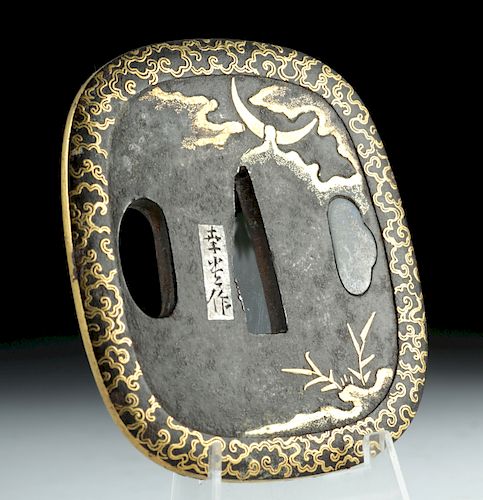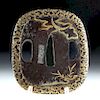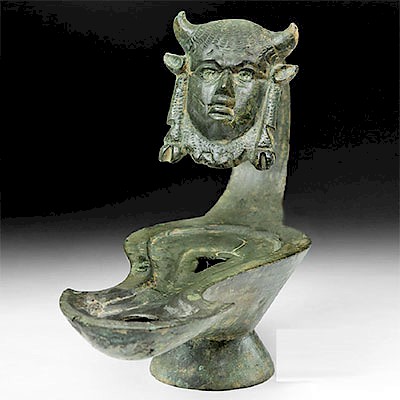Signed 19th C. Japanese Edo Period Iron & Gold Tsuba
Lot 116a
About Seller
Artemis Fine Arts
686 S Taylor Ave, Ste 106
Louisville, CO 80027
United States
Selling antiquities, ancient and ethnographic art online since 1993, Artemis Gallery specializes in Classical Antiquities (Egyptian, Greek, Roman, Near Eastern), Asian, Pre-Columbian, African / Tribal / Oceanographic art. Our extensive inventory includes pottery, stone, metal, wood, glass and textil...Read more
Estimate:
$1,000 - $1,500
Absentee vs Live bid
Two ways to bid:
- Leave a max absentee bid and the platform will bid on your behalf up to your maximum bid during the live auction.
- Bid live during the auction and your bids will be submitted real-time to the auctioneer.
Bid Increments
| Price | Bid Increment |
|---|---|
| $0 | $25 |
| $300 | $50 |
| $1,000 | $100 |
| $2,000 | $250 |
| $5,000 | $500 |
| $10,000 | $1,000 |
| $20,000 | $2,500 |
| $50,000 | $5,000 |
| $100,000 | $10,000 |
| $200,000 | $20,000 |
About Auction
By Artemis Fine Arts
Sep 27, 2018
Set Reminder
2018-09-27 10:00:00
2018-09-27 10:00:00
America/New_York
Bidsquare
Bidsquare : Antiquities | Asian | Ethnographic
https://www.bidsquare.com/auctions/artemis-gallery/antiquities-asian-ethnographic-3469
Featuring classical antiquities, ancient and ethnographic art from cultures encompassing the globe. Artemis Fine Arts info@artemisgallery.com
Featuring classical antiquities, ancient and ethnographic art from cultures encompassing the globe. Artemis Fine Arts info@artemisgallery.com
- Lot Description
East Asia, Japan, late Edo Period, ca. early to mid-19th century CE, signed (likely Yukimitsu - see more below). A beautiful forged-iron Kaku Gata tsuba, a square-shaped hand guard with rounded corners traditionally employed on Japanese swords. The obverse side of the tsuba displays a nocturnal scene with a pair of bamboo stalks growing upwards towards a cloud-shrouded crescent moon, and the reverse depicts a trio of minimalist birds in flight above uneven terrain, all in inlaid gold. The exterior rim displays a wispy pattern of curvilinear motifs, and the edge is lined with gold as well. The central blade opening (Nakago-ana) is flanked by a pair of decorative holes, one filled and with a small protrusion on one side (Kogai Hitsu-ana) and an open one without a protrusion (Hozuka Hitsu-ana). Though the old-style characters are somewhat difficult to translate, a small rectangular panel near the central opening bears a signature that likely reads "Yukimitsu". Size: 2.375" W x 2.7" H (6 cm x 6.9 cm).
A tsuba is the hand guard of a traditional Japanese sword, usually a katana or tachi. Its primary purposes are to balance the sword, prevent one's hand from sliding down the blade and, as a last resort, as a block against an opponent's thrust or slash. However, as time and skills developed, the tsuba evolved into an artistic item and symbol representing wealth, prestige, or skills as a swordsman. Early tsuba, known as neri tsuba, were made of leather encased in an iron or wooden frame which was occasionally lacquered for strength and stability.
Provenance: ex-private Rochester, Michigan, USA collection
All items legal to buy/sell under U.S. Statute covering cultural patrimony Code 2600, CHAPTER 14, and are guaranteed to be as described or your money back.
A Certificate of Authenticity will accompany all winning bids.
We ship worldwide and handle all shipping in-house for your convenience.
#138144Surface wear and minor abrasions commensurate with age, light fading to signature, light patina to some gold components, and very minor nicks around blade opening, otherwise intact and excellent. Light earthen deposits and nice, even oxidation to exposed iron areas.Condition
- Shipping Info
-
All shipping is handled in-house for your convenience. Your invoice from Artemis Gallery will include shipping calculation instructions. If in doubt, please inquire BEFORE bidding for estimated shipping costs for individual items.
-
- Buyer's Premium



 EUR
EUR CAD
CAD AUD
AUD GBP
GBP MXN
MXN HKD
HKD CNY
CNY MYR
MYR SEK
SEK SGD
SGD CHF
CHF THB
THB













